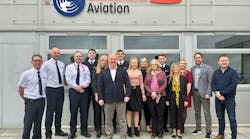In 2015, Imperial Aviation LLC took over the FBO at Stinson Municipal Airport (SSF) in San Antonio.
As the feeder airport for San Antonio International Airport, Stinson provides unique opportunities for the region and general aviation and business traffic looking to access the area.
Airport Business recently spoke with Thomas Mathew, CEO of Imperial, which is doing business as GateOne Stinson at SSF and shared a little more about business and the current state of general aviation in the region.
Airport Business: Tells me a little about the current state of business and general aviation traffic in the San Antonio Region and at Stinson Municipal Airport.
Thomas Mathew: It’s great where we’re located. Stinson is what you call a feeder airport to San Antonio International. We’ve got a couple of flight schools there, we’ve got 80-plus airplanes based there and we’ve got a lot of constant customers that come through. One of the reason we looked at basing ourselves as the FBO at Stinson is the fact that there’s a lot of industry that’s going into the south side of San Antonio. Also, the shale oil play in Southern Texas is also heating up. There’s a lot more aircraft that are coming through Stinson. We have a world-class FBO there and we compete with everyone else there very effectively.
AB: Being that Stinson is a reliever airport to San Antonio International Airport, how are you able to compete? What kinds of advantages do you have at that airport?
TM: When we bought the place we moved from a 30-year-old facility to a brand new facility in the terminal building. That facility basically provides all the amenities that you would find at a major FBO. We provide every service that you can get and we’re very competitive with our fuel prices. At the same time, we don’t have any fees attached to the services that we provide.
AB: What do you see as the big opportunities for your FBO at Stinson?
TM: When we purchase an FBO we look at the growth potential. We know what it has been doing historically. We look at the added value to the services we can bring to that location. They had a great maintenance facility. We upgraded that to where we’re a Robinson Helicopter maintenance facility. We have a lot of aircraft that comes to our facility because of the reputation our maintenance facility has. For a pilot that’s cost conscious on fuel prices, we’re very effective in our pricing in terms of how we provide that value to the flying public. They’re not missing out by not going to San Antonio International. Plus, we’re six miles closer to the middle of San Antonio and the river walk and all the other facilities in San Antonio.
AB: It has been three years since you took over the FBO. Can you tell me more about the changes and what you’re aiming for with the upgrades you’re making?
TM: Once we took it over, obviously a 30-year-old facility did not meet our standards. The airport had already added on and built out to our terminal and they had a brand new facility that we could lease, modify and convert to our FBO base at the main terminal. We were able to incorporate all the modern amenities that pilots flying through would need, so they have a great facility there to use when they want to.
AB: How did you go through the process of determining what those amenities would be and what pilots want?
TM: I’m a pilot myself. Over the years when I was flying, I used what I would look for in a facility. I made sure that when we bought and changed the makeup of an older facility that we provided everything that a major FBO would at a major airport. At the end of the day, there should be nothing lacking to the pilot’s needs or the passengers’ needs when they come through our facility.
AB: What are the challenges on the horizon that you need to be prepared for?
TM: Obviously, the most volatile thing is the price of fuel. That dictates a lot in terms of what we have to look for. We can only pass through a certain percentage of the increase in fuel prices, so we’re conscious that we check the pricing with, I’d say about 50 FBOs in a 200 to 300 mile range just to make sure we’re competitive yet at the same time providing a good product. The other thing is that we look at the flying public that comes into our facility and see what their needs are and what they need and we move accordingly to provide that service if we’re not providing it at the moment.
AB: Are you having the same challenges with finding talent in Texas that other aviation companies have across the country?
TM: Having the right talent is very critical, especially at the level of a general manager and the line service managers. At San Antonio, our line crew has more than 45 years of experience in the industry. From the level of expertise that we provide and the level of service we provide our location, there’s nothing like it. What we have done, other than the key people that we have as line men, we also hire people that have the inclination to work at an FBO and train them from the ground up. At the end of the day, in three to six months, we have a fully qualified person. But obviously with the economy doing great, people can pay a lot more in other industries so there’s a certain amount of attrition. But, we have been successful in being able to keep the people that are working for us and making sure we take care of them whether it’s by benefits or pay and we’re providing a great work environment.
AB: What are you concerned about at an industry level that could impact your FBO?
TM: From the FBO level, we’ve already dealt with plenty of challenges in terms of regulation. Same thing with local regulation because a lot of the FBOs have to comply with the minimum standards that the airport authorities in the local areas impose on us. Other than the business itself and what we need to do to change with the times, we’ve not had issues that make a big difference in the industry for us.





